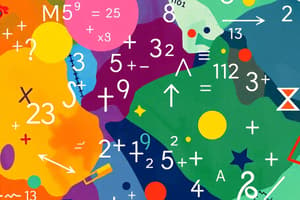Podcast
Questions and Answers
What is the order of operations in mathematics known as?
What is the order of operations in mathematics known as?
PEMDAS.
What is a variable in algebra?
What is a variable in algebra?
A symbol that represents a number.
What formula is used to calculate the area of a rectangle?
What formula is used to calculate the area of a rectangle?
Area = length × width.
What do the sine and cosine functions represent in trigonometry?
What do the sine and cosine functions represent in trigonometry?
What is a prime number?
What is a prime number?
What is the formula for calculating simple interest?
What is the formula for calculating simple interest?
How can you determine the future value of an investment?
How can you determine the future value of an investment?
What is an annuity, and how is it used in financial mathematics?
What is an annuity, and how is it used in financial mathematics?
Name one tool that can be used for visualizing functions and data.
Name one tool that can be used for visualizing functions and data.
What is one common mistake students make when working with mathematical expressions?
What is one common mistake students make when working with mathematical expressions?
Flashcards are hidden until you start studying
Study Notes
Key Concepts in Mathematics
1. Basic Arithmetic
- Operations: Addition, Subtraction, Multiplication, Division
- Order of Operations: PEMDAS (Parentheses, Exponents, Multiplication and Division (left to right), Addition and Subtraction (left to right))
2. Algebra
- Variables: Symbols that represent numbers (e.g., x, y)
- Expressions: Combinations of variables and constants (e.g., 2x + 3)
- Equations: Statements that two expressions are equal (e.g., 2x + 3 = 7)
- Functions: Relationships where each input has a single output (e.g., f(x) = x^2)
3. Geometry
- Shapes: Circles, triangles, squares, rectangles, polygons
- Properties: Perimeter, area, volume
- Rectangle: Area = length × width
- Circle: Area = πr²
- Theorems: Pythagorean theorem (a² + b² = c² for right triangles)
4. Trigonometry
- Functions: Sine (sin), Cosine (cos), Tangent (tan)
- Right Triangle Relationships: Opposite, Adjacent, Hypotenuse
- Unit Circle: Circle with a radius of 1, used to define trigonometric functions
5. Calculus
- Limits: The value that a function approaches as the input approaches a point
- Derivatives: Measure of how a function changes as its input changes
- Integrals: Measure of the area under a curve
6. Statistics
- Descriptive Statistics: Mean, median, mode, range
- Probability: Likelihood of an event occurring
- Distributions: Normal distribution, binomial distribution
7. Number Theory
- Prime Numbers: Numbers greater than 1 that have no divisors other than 1 and themselves
- Factors and Multiples: Factors are numbers that divide another number without leaving a remainder, multiples are the result of multiplying a number by an integer
8. Financial Mathematics
- Interest: Simple interest (I = PRT) and compound interest
- Annuities: Series of equal payments at regular intervals
- Present Value and Future Value: Calculating the current worth of cash flows or the worth of current cash flows at a future date
Math Tools
- Calculators: For performing complex calculations
- Graphing Software: For visualizing functions and data
- Spreadsheets: For statistical analysis and data management
Study Tips
- Practice Problems: Reinforces concepts and improves problem-solving skills
- Flashcards: Useful for memorizing formulas and definitions
- Group Study: Discussing topics with peers enhances understanding and retention
Common Mistakes
- Misapplying the order of operations
- Failing to simplify expressions fully
- Misunderstanding the concepts of angles in trigonometry
Resources
- Online tutorials (e.g., Khan Academy)
- Math textbooks for in-depth explanations
- Study groups and tutoring for personalized assistance
Key Concepts in Mathematics
Basic Arithmetic
- Operations include Addition, Subtraction, Multiplication, and Division.
- Order of Operations follows PEMDAS: Parentheses, Exponents, Multiplication and Division (left to right), Addition and Subtraction (left to right).
Algebra
- Variables are symbols (e.g., x, y) representing unknown values.
- Expressions combine variables and constants (e.g., (2x + 3)).
- Equations assert equality between two expressions (e.g., (2x + 3 = 7)).
- Functions describe relationships with one output for each input (e.g., (f(x) = x^2)).
Geometry
- Shapes include Circles, Triangles, Squares, Rectangles, and Polygons.
- Properties are essential measurements like Perimeter, Area, and Volume:
- Rectangle: Area calculated as length × width.
- Circle: Area given by the formula (πr²).
- Theorems such as the Pythagorean theorem state that for right triangles, (a² + b² = c²).
Trigonometry
- Functions primarily consist of Sine (sin), Cosine (cos), and Tangent (tan).
- Right Triangle Relationships define sides as opposite, adjacent, and hypotenuse.
- Unit Circle is pivotal for defining trigonometric functions, having a radius of 1.
Calculus
- Limits indicate the value a function nears as inputs approach a specific point.
- Derivatives measure the rate at which a function changes with respect to an input.
- Integrals assess the area beneath a curve over a specified interval.
Statistics
- Descriptive Statistics provide insights through Mean, Median, Mode, and Range.
- Probability quantifies the chance of event occurrence.
- Distributions include Normal and Binomial distributions, each describing data spread.
Number Theory
- Prime Numbers are those greater than 1, only divisible by 1 and themselves.
- Factors and Multiples: Factors divide a number without a remainder, while multiples result from multiplying a number by integers.
Financial Mathematics
- Interest can be calculated using Simple interest (I = PRT) or Compound interest formulas.
- Annuities refer to regular payments made at fixed intervals.
- Present Value and Future Value concepts calculate worth across different time frames.
Math Tools
- Calculators assist in executing complex arithmetic and algebraic operations.
- Graphing Software aids in visualizing equations, functions, and data sets.
- Spreadsheets facilitate statistical analysis and organization of data.
Study Tips
- Practice Problems help solidify understanding and enhance problem-solving abilities.
- Flashcards serve as effective tools for memorizing key formulas and definitions.
- Group Study encourages discussion, promoting deeper comprehension and memory retention.
Common Mistakes
- Misapplying the order of operations can lead to incorrect results.
- Incomplete simplification of expressions may obscure underlying relationships.
- Misunderstanding angles in trigonometry commonly impedes accurate calculations.
Resources
- Online tutorials like Khan Academy offer specialized instruction on various topics.
- Math textbooks provide thorough explanations and additional examples.
- Study groups and tutoring sessions promote individualized learning experiences.
Studying That Suits You
Use AI to generate personalized quizzes and flashcards to suit your learning preferences.




